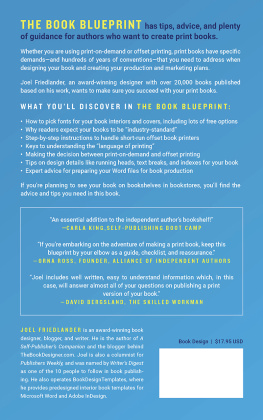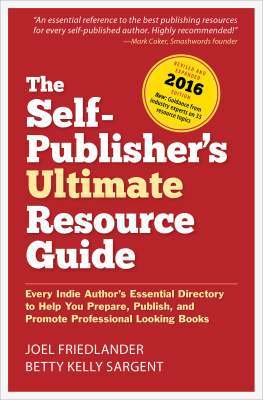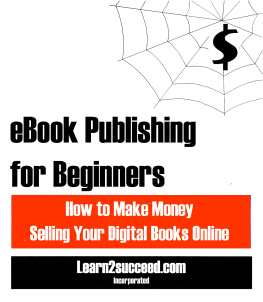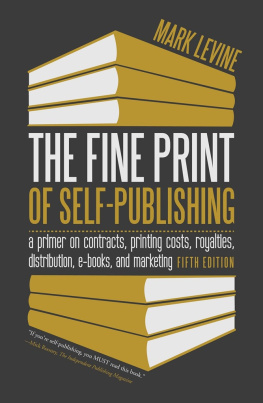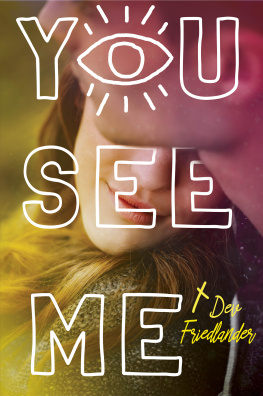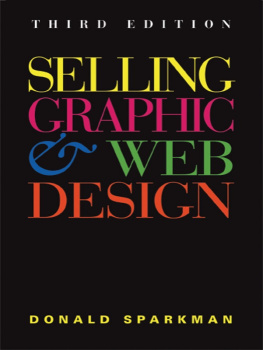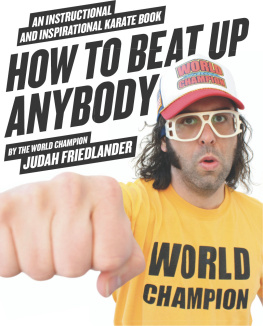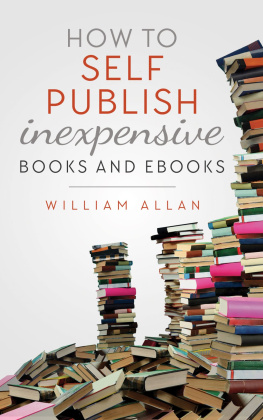Are you ready for a quick and easy way to produce your book interior?
BOOK DESIGN TEMPLATES
from TheBookDesigner.com
Beautiful, industry-standard, predesigned book templates for use in Microsoft Word, Apple Pages, and Adobe InDesign.
- Now you can quickly and easily create beautiful print books and ebooks right in Microsoft Word, Apple Pages, and Adobe InDesign
- Built to industry-standard specifications, our template styles will make your book stand out, without all those newbie mistakes
- Handcrafted by an award-winning book designer, each template comes with the fonts you need and a variety of trim sizes
- DIY or use our done-for-you layout services
To find out more: http://www.bookdesigntemplates.com
The Book Blueprint
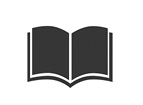
Expert Advice for Creating
Industry-Standard Print Books
Joel Friedlander
Marin Bookworks San Rafael
For more tips and advice on making and
marketing print books, please visit
TheBookDesigner.com
Note: Most of the content for this book originated in slightly different form on my website at TheBookDesigner.com . The first edition of this book was titled The Book Construction Blueprint .
Copyright 2018 by Joel Friedlander.
All rights reserved. No part of this publication may be reproduced, distributed or transmitted in any form or by any means, including photocopying, recording, or other electronic or mechanical methods, without the prior written permission of the publisher, except in the case of brief quotations embodied in critical reviews and certain other noncommercial uses permitted by copyright law. For permission requests, write to the publisher, addressed Attention: Permissions Coordinator, at the address below.
Marin Bookworks
369-B Third Street #572
San Rafael, CA 94901
www.thebookdesigner.com
Ordering Information:
Quantity sales. Special discounts are available on quantity purchases by corporations, associations, and others. For details, contact the Special Sales Department at the address above.
Book design and production: Marin Bookworks
Editorial assistance: Kathryn Mazur
Editing: Wyn Hilty
Screenshots: AskMaxDesigns.com
Layout: Adina Cucicov
Cover design: Ebook Launch
Typefaces used in this book: Chaparral Pro, Droid Sans, Helvetica Neue
Printed in the United States of America
The Book Blueprint / Joel Friedlander. 2nd ed.
ISBN 978-0-936385-45-7 Trade paper
ISBN 978-0-936385-48-8 Ebook
Preface
W hen print-on-demand technology arrived, it started a revolution in self-publishing. Authors were freed of the financial risk associated with book publishing, and thousands of entrepreneurial authors jumped at the chance to quickly and economically get their books onto the market.
Then Amazons Kindle opened the floodgates even wider, and writers began to publish in direct to digital (ebook) formats, and the explosion just kept getting bigger and bigger.
Since then the maturing market for ebooks has lured many writers into publishing their own books, and some have had great success. Bloggers and online entrepreneurs got into the act too, swelling the ranks of self-published ebook authors.
Somehow in all the hullabaloo generated by million-copy-selling ebooks and the sensible migration of a lot of genre fiction to ebook platforms, the primacy of print books was overlooked.
After all, the vast majority of books published today are print books, and most of those are printed by traditional offset printing.
But the complications and requirements of print books have kept a lot of authors away, and thats a shame. All those print books being sold should tell us that readers love print books. Why not take advantage of this continuing love affair with print by getting into this market yourself?
In Book Construction Blueprint Ive brought together all the writing Ive done over the last eight years about how to create beautiful, industry-standard print books. Most of the material has been gathered from articles on my blog, TheBookDesigner.com. Other content was derived from instructional materials Ive prepared for a variety of colleagues and companies involved in the production of print books.
Why, you might ask, would I publish a book about a technology that many indie authors consider irrelevant? Why bog you down with all the traditions, language, and procedures of a process with its origins in the sixteenth century, when everyone else seems to be excited about the latest social media platform?
The next step for successful indie authors has been apparent for several years. I expected to see these authors begin to make the transition from self-publishers to publishers of books from a variety of authors by acquiring books that will appeal to the audience theyve already established. By setting up small presses or cooperatives of authors, they will realize how efficient the division of labor can be when more than one person is working on book projects.
And thats exactly what is coming to pass. At the same time, these new publishers, seeking larger audiences than they can amass online, will try to get their books into bookstores through the existing distribution systemarchaic though it is.
When indie authors discover the need to move their books into print versions, and their requirements outstrip the economic advantages of print on demand, there should arise a new appreciation of and investment in offset-printed books.
Whether you are preparing a book for offset or for distribution through a leading print-on-demand vendor, youll still need guidance in how to put together your book properly.
Thats what youll find here. Book Construction Blueprint is not a comprehensive treatise on design, and its not a step-by-step approach to production. Its an accumulation of advice, tips, explanations, and authoritative recommendations for anyone creating a print book.
I hope it helps you on your own publishing journey.
Joel Friedlander
San Rafael, California
Introduction
T odays author-publishers publish many more books in ebook formats than they publish in print. Its not hard to see why this is so.
Print books generally require a lot more work to get ready for publication than do ebooks. First, you need to set the general parameters for your print book, including making decisions about things like:
- The books size
- What kind of paper to use
- How many colors of ink will be used to print the book
- How the book will be bound
- How many copies will be printed, or whether to use print-on-demand technology
- The way books will go from production, to distribution, and eventually, to retail
Although print-on-demand vendors like CreateSpace and IngramSpark have tried to make this process more user-friendly, ease of use comes at the price of severely limiting the options available because standardization makes the print-on-demand world run efficiently.
Most authors havent realized that the vast majority of print books sold are not from print-on-demand vendors: they are produced using offset printing. Offset allows publishers to access a large universe of choices in book sizes and styles of binding, in printing papers of all kinds, and at various quality levels.
Add to this the difficulty most authors would have identifying the right printer for their book, getting accurate estimates from the printer, and preparing files according to the printers specifications. Offset book printers are primarily business-to-business operations, unused to catering to authors with one book who need a lot of education on the production process.
Next page
